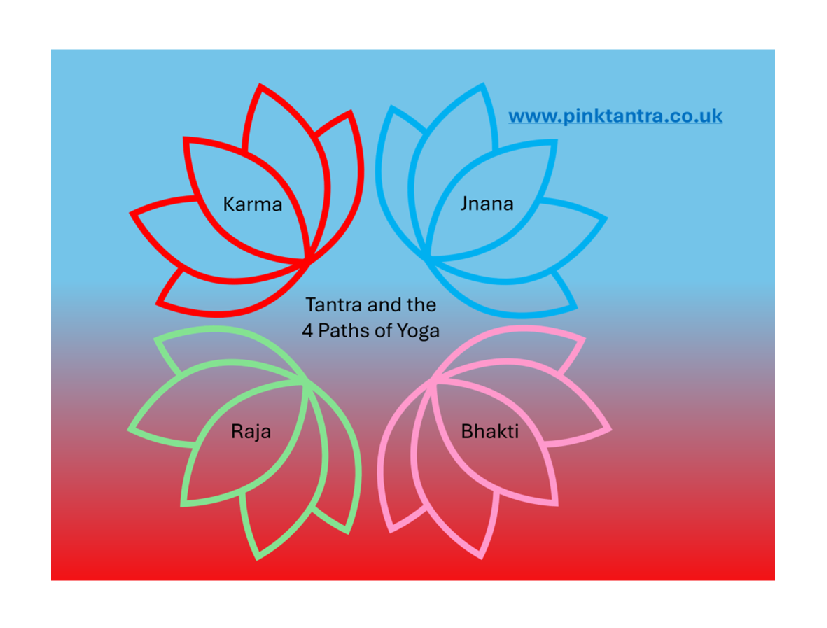Tantra and the 4 Paths of Yoga
Tantra is often translated as ‘to weave’ and so weaves together many different techniques from the various yoga’s (indeed Tantra was a major influence on many of the yoga’s we often hear referred to these days, such as, Kriya Yoga, Mantra Yoga, Hatha Yoga, and Kundalini Yoga).
 I have received a number of comments recently on my post Tantra Yoga (and the 3 bodies). Questions really on how this sits alongside ‘traditional’ yoga. By traditional yoga people tend to mean either Hatha Yoga or the Four Paths of Yoga.
I have received a number of comments recently on my post Tantra Yoga (and the 3 bodies). Questions really on how this sits alongside ‘traditional’ yoga. By traditional yoga people tend to mean either Hatha Yoga or the Four Paths of Yoga.
So, first, what is Hatha Yoga? Essentially, it is an umbrella term for many of the various yoga’s we know of in the West combining asanas and pranayama (postures and breathwork). It’s main focus is on the mastery of the body. Patanjali, in The Yoga Sutras, includes three brief references to body postures as part of the Eightfold Path, or Eight Limbs of Yoga, from which Hatha Yoga is derived.
What then are the Four Paths of Yoga? These are yoga (spiritual) philosophies for enlightenment; Jnana Yoga, Karma Yoga, Raja Yoga and Bhakti Yoga.
Jnana Yoga couldn’t be further from Hatha Yoga, it is the Path of Knowledge of the Self (or Path of Wisdom). It is the practice of self-enquiry to gain true self-awareness beyond the ego, an inner examination that cultivates openness, and questions Who Am I? Although it encourages a reading of such things as the Upanishads and Bhagavad Gita, it is not just intellectual, but rather steps beyond the intellect to insight. We can see this approach currently in the work of people like Adyashanti, Rupert Spira, and others.
Karma Yoga is often called either the Yoga of Action or the Yoga of Duty. Karma can mean either. This is about selfless and ‘right’ action, by which is meant wise or skilful action. Karma is both, as Sogyal Rinpoche, the Buddhist Master, in The Tibetan Book of Living and Dying, says, “the power latent within actions, and the results our actions bring.” The purpose therefore is to bring selfless (desireless) action into our daily life, without being attached to the outcome.
Raja Yoga, the Path of Self-Control, was also known as Ashtanga Yoga. However, a very different Ashtanga Yoga than we tend to think of these days. Originally Ashtanga was the ‘Eight Limbs of Yoga’ which were the eight steps needed for self-realisation. Not the highly structured asana sequence we now think of as Ashtanga Yoga, developed initially for Sri Pattabhi Jois by T. Krishnamacharya as an personalised practice in the 20th century. So, not a physical yoga like Hatha Yoga, but philosophical and spiritual practice of self-control, as noted in Patanjali’s Yoga Sutra, for achieving enlightenment.
Bhakti Yoga is the path of devotion, sometimes called the Yoga of Love. This is about surrendering to the divine, or to something larger than oneself. There will be a strong emotional connection to either a deity, a master or guru, or some other higher power. This need not be external to ourselves, but rather our own inner higher power, such as that practiced in Kundalini Tantra Yoga where we seek to awaken our inner divine (kundalini energy), fostering true awareness, uniting with universal consciousness. Kundalini Tantra Yoga is also called the Yoga of Inner Awareness and Presence.
And so, how does any of this fit with Tantra Yoga?
Tantra Yoga works with our energies, working more on the subtle body than the physical body (such as our kundalini energy as mentioned in Kundalini Tantra Yoga). However, in the West, Tantra Yoga (through the route of neo-tantra of sacred sexuality) has taken on a more specific definition utilising our sexual energy to enhance our spiritual growth and enlightenment. Here practitioners work with the physical body, before shifting to the energetic body to contain, expand and direct sexual energy, thereby skilfully using the energy to move to ‘the beyond’ (eg, connect to universal consciousness).
Bringing it all together
Tantra encompasses the whole person and all of life, bringing a systematic approach to daily life, sex life, as well as rituals and yogic practices. What is considered Tantra Yoga is as diverse as you would expect from something that attempts to encompass the whole person and all of life, from the likes of Christopher Wallis with a more Jnana Yoga approach, to Daniel Odier who has a more Bhakti Yoga approach. But what is key is the work around our energies and our subtle body that Tantric practitioners employ.
Connect on Twitter / Instagram / Facebook
Message me direct if you are interested in mindful, embodied, trauma-informed, or spiritually-informed 1-1 coaching robert.pinktantra@gmail.com
See my new course Kundalini Tantra Yoga – Working up the Chakras, due to start Monday 9 September 2024, 7.30am BST
See my personal development / personality profiling book DISCover the Power of You published through John Hunt Publishing Ltd, 2017. ISBN: 978-1-78535-591-2
And for those who enjoy historical fiction, stories of underrepresented life’s, see my first novel Fermented Spirits published through Austin Macauley Publishers, 2022. ISBN-13: 978-1398437159